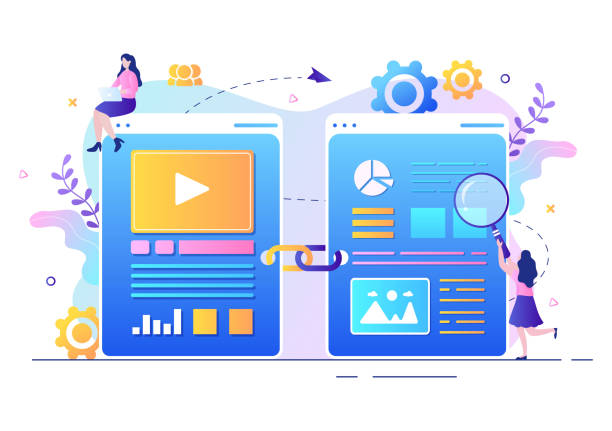The Importance of Fast Website Design in Today’s Digital World

In the current digital age, website loading speed is not just a competitive advantage, but a vital necessity.
#Web_speed plays a pivotal role in the success of any online business, as it directly impacts #user_experience and #SEO rankings.
Websites that load quickly are able to retain visitors for longer and significantly reduce the bounce rate.
This means increasing the chance of converting a visitor into a customer or loyal user.
On the other hand, search engines like Google consider loading speed as an important factor in page rankings.
Therefore, a fast website design can directly help improve your website’s position in search results.
Investing in speed optimization is, in fact, an investment in user satisfaction and increased revenue.
Understanding these basic principles is essential for anyone who intends to succeed in the online space.
Designing a fast-loading website not only increases your credibility but also demonstrates your commitment to providing the best possible user experience.
Did you know your company’s website is the first point of contact for 75% of potential customers?
Your website is the face of your brand. With **RasaWeb**’s corporate website design services, create an online presence that earns customer trust.
✅ Create a professional and lasting image for your brand
✅ Attract target customers and increase online credibility
⚡ Get a free consultation from **RasaWeb** experts!
Impact of Loading Speed on SEO and Conversion Rate

Website loading speed is one of the most important SEO factors that search engines like Google seriously consider.
Google uses metrics like #Core_Web_Vitals to evaluate user experience on websites, which include Largest Contentful Paint (LCP), First Input Delay (FID), and Cumulative Layout Shift (CLS).
Websites that perform poorly on these metrics may face difficulties in search rankings.
A high #bounce_rate, caused by slow site speed, sends negative signals to search engines, indicating that users quickly leave your site.
This means lost opportunities for business and inefficiency in customer acquisition.
A slow website can lead to losing about half of its visitors, even before they see your content.
From a #user-centric perspective, user expectations for page loading have dropped to less than three seconds; beyond this time, frustration begins, and the likelihood of user exit increases.
Therefore, fast website design and its continuous optimization are not only vital for achieving higher rankings on Google but also essential for increasing conversion rates and, ultimately, the sustainable growth of your business.
All these factors are interconnected, and a comprehensive strategy for site speed can make a big difference in your online success.
Key Principles in Fast Website Development and Design

To achieve fast website design, adhering to several key principles during the development process is essential.
These principles include code optimization, proper use of images and media, and leveraging compression and caching.
One of the initial steps is #HTML_CSS_JavaScript_code_optimization.
This means reducing file sizes (Minification) and removing unnecessary code (Tree Shaking), which helps the browser load content faster.
Using #responsive_images, optimized for various devices and sizes, is of great importance.
This prevents loading large-sized images for devices with smaller screens.
Additionally, enabling #Gzip_compression on the server-side is highly recommended.
Gzip can reduce the size of text files (such as HTML, CSS, JavaScript) by up to 70%, thereby significantly improving loading times.
Choosing lightweight frameworks and libraries in development can also help increase speed.
Below, a table comparing web development methods in terms of speed is provided, which can assist you in selecting the appropriate approach for a fast and efficient website:
| Development Method | Speed Advantages | Potential Challenges |
|---|---|---|
| Vanilla Code Development | Smaller code size, full control over optimization | Longer development time, high expertise required |
| Lightweight Frameworks (e.g., Vue.js, React) | Faster development, built-in optimization, SPA | Larger initial size, SEO complexity (if no Server-Side Rendering) |
| Content Management Systems (CMS – e.g., WordPress) | Ease of management, numerous plugins | Requires precise optimization, heavy plugins |
| Static Site Generators | Unparalleled speed, high security, scalability | Requires rebuilding for changes, suitable for static content |
Choosing the right approach for fast website design depends on the project’s needs and available resources.
However, in any case, focusing on basic optimization principles is key to success.
Optimizing Images and Media to Increase Site Speed

Images and media files often constitute the largest data volume on a website and can significantly impact loading speed.
To achieve fast website design, precise optimization of these elements is essential.
The first step is choosing the appropriate #image_formats.
Formats like WebP are highly recommended due to high compression while maintaining acceptable quality.
JPEG is suitable for photographic images, and PNG for images with transparency or logos.
Next, images should be compressed without noticeable loss of quality (lossless compression) or with minimal quality loss (lossy compression).
Many online and offline tools are available for this.
The next step is resizing images to the actual dimensions needed on the website.
Loading an image with dimensions of 2000×1500 pixels where only 500×375 pixels are needed is a waste of bandwidth and time.
Implementing #lazy_loading is also a very effective technique; with this method, images are loaded only when the user scrolls to the relevant part of the page.
This significantly helps reduce the initial page load time.
For videos, compression and the use of modern formats like MP4 with H.264 or H.265 codecs, and hosting on specialized platforms (such as YouTube or Vimeo) instead of direct hosting on your own server, are recommended.
By observing these points in the fast website design process, we can have a significant impact on the overall performance of the website.
Are you tired of your e-commerce website not generating as much revenue as it could? RasaWeb, specialized in professional e-commerce website design, solves this problem forever!
✅ Increase sales rate and revenue
✅ High loading speed and exceptional user experience
⚡ Get a free consultation for e-commerce website design
The Role of Caching and CDN in Accelerating Page Loading

To achieve fast website design, the use of caching mechanisms and Content Delivery Networks (CDNs) is critically important.
Caching means storing copies of website content (such as images, CSS files, JavaScript, and even entire pages) in locations closer to the user or in their browser’s memory.
This ensures that on subsequent visits, there is no need to reload from the main server, and the page loads significantly faster.
Types of caching include #Browser_Caching, #Server_Caching, and Application-level Caching.
Browser caching allows the user’s browser to store static files, while server caching reduces the load on the server by storing database query results or generated pages.
However, a Content Delivery Network (CDN) goes a step further.
A CDN is a network of global servers that store copies of your website’s static content at various geographical locations (Points of Presence or PoPs).
When a user accesses your website, the CDN delivers content from the server closest to that user’s geographical location.
This reduces the physical distance and minimizes latency, thereby significantly increasing loading speed.
A CDN can also provide protection against DDoS attacks and enhance website reliability.
Proper implementation of caching and CDN is among the necessary measures in any fast website design project, significantly contributing to improved user experience and SEO rankings.
Server-Side Optimization and Choosing the Right Host

Beyond website coding and content, server performance and hosting infrastructure play a crucial role in fast website design.
Choosing #high-speed_and_reliable_hosting is the first step.
Shared hosting is often suitable for small websites with low traffic, but for larger projects, Virtual Private Servers (VPS), Dedicated Servers, or Cloud Hosting are better options that offer more resources.
#Database_optimization is also of high importance.
Ensuring that the database is well-designed and its queries are optimized (e.g., by using proper indexing) can significantly reduce server response time.
Configuring web servers (such as Apache or Nginx) to enable Gzip compression and browser caching is also essential.
Using the latest versions of the #HTTP_2_protocol instead of HTTP/1.1 can lead to significant improvements in loading speed.
HTTP/2 allows for concurrent sending of multiple requests and has less overhead.
Additionally, enabling Keep-Alive and correctly setting HTTP headers can help reduce the number of requests and connection time.
From a software perspective, ensuring that the server’s operating system, web server software, and the PHP or Python versions used are up-to-date is crucial due to performance and security enhancements.
These server-side measures form the backbone of a fast and stable website design and should not be overlooked.
Cleaning and Optimizing HTML, CSS, and JavaScript Code

Clean and optimized code is the cornerstone of any fast website design.
Every extra byte of code or unoptimized structure can lead to website sluggishness.
The first step in this regard is #Minification or code minification.
This process involves removing extra characters such as white spaces, new lines, comments, and long variable names from HTML, CSS, and JavaScript files.
The goal is to minimize file sizes without altering their functionality.
This can significantly reduce initial loading time.
Regarding CSS, optimization includes removing unused styles and reducing the complexity of selectors.
Using #Critical_CSS is also an advanced technique that places essential CSS for the initial page display at the top of the HTML document and defers the loading of the rest of the CSS.
For JavaScript, in addition to Minification, the #Asynchronous_Loading (Async and Defer) technique for scripts is very important.
These attributes allow the browser to continue loading JavaScript without blocking page rendering, which is especially useful for large and non-essential scripts for initial display.
Also, reducing the number of HTTP requests by combining CSS and JS files (if not using HTTP/2) and avoiding render-blocking JavaScript are other important points.
Below, a table of common coding problems and speed improvement solutions is provided:
| Problem | Description | Solution |
|---|---|---|
| Large and uncompressed JS/CSS files | Increased loading time due to large file sizes | Minification and Compression (Gzip) |
| Render-blocking JavaScript | Browser waits for JS execution and doesn’t display the page | Use async/defer attributes, or move JS to the end of <body></body> |
| Unused CSS | Loading styles that are not used on the current page | Remove unused CSS, or use Critical CSS |
| Too many HTTP requests | Browser needs to send multiple requests to the server | Combine files (sprites), use CDN and caching |
| Image optimization not done | Images with inappropriate dimensions and sizes | Resize, compress, use modern formats (WebP), Lazy Loading |
Following these recommendations can significantly help improve your website’s loading speed and performance and provide a better user experience.
Tools and Metrics for Website Speed Measurement

After implementing various techniques for fast website design, the next step is to measure and monitor its performance.
There are several tools that help you analyze your website’s speed, identify problems, and discover solutions for improvement.
One of the most widely used tools is Google’s #PageSpeed_Insights.
This tool gives you performance scores for desktop and mobile versions of your website and provides suggestions for improvement.
Another is #GTmetrix, which offers more detailed reports on loading time, number of requests, and scores related to YSlow and PageSpeed (older metrics).
This tool also displays a waterfall of resource loading, which helps you identify blocking resources.
#Lighthouse, also available in Chrome DevTools, is a comprehensive tool for checking performance, accessibility, SEO best practices, and Progressive Web App (PWA) capabilities.
This tool not only provides performance scores but also examines #Core_Web_Vitals factors and presents opportunities for improvement.
In addition, tools like WebPageTest and Pingdom are popular, offering more advanced features such as testing from different geographical locations and simulating various connection speeds.
Regular use of these tools and focusing on resolving identified issues is a crucial step in maintaining and continuously improving website speed, helping you always stay a step ahead.
Are you concerned about your e-commerce site’s low conversion rate and not achieving your desired sales?
RasaWeb is your specialized solution for a successful e-commerce site.
✅ Significant increase in conversion rate and sales
/>
✅ Professional and user-friendly design to attract customer satisfaction
⚡ Ready for a transformation in online sales? Get a free consultation!
Common Mistakes in Website Design and Solutions to Avoid Them

In the pursuit of achieving fast website design, designers and developers may make common mistakes that can severely impact website performance.
Identifying and avoiding these mistakes is very important.
One of the biggest mistakes is the excessive use of #extra_plugins and add-ons in Content Management Systems like WordPress.
Every plugin, even if small, can add extra code and requests to the site and reduce speed.
The solution is to use only essential and optimized plugins and regularly remove unused ones.
Another common mistake is loading #large_and_unoptimized_images.
Many websites load images with high dimensions and quality, leading to large page sizes.
Always optimize images before uploading and use modern formats like WebP.
#Render-blocking_JavaScript is also a major slowing factor.
If scripts are placed in the <head> section of the page, the browser must wait for them to load and execute before it can display the page content.
The solution is to load scripts using the `async` and `defer` attributes or move them to the end of the <body> tag.
Failure to use caching and CDN is also a big mistake.
Without these tools, every time a user visits the site, all content must be loaded from the main server.
These mistakes can nullify your efforts for fast website design, so always pay attention to these points.
Future Trends in Web Performance and Fast Website Design

The world of the web is constantly evolving, and with it, technologies related to fast website design are also advancing.
Understanding future trends can help developers prepare themselves for upcoming challenges and opportunities.
One of these trends is the expanding use of Progressive Web Apps (PWAs).
PWAs enable websites to function like native applications on mobile devices, support offline capabilities, and send push notifications.
This significantly improves the user experience and increases the speed of content access.
Accelerated Mobile Pages (AMP) also remains an option for news content and blogs.
AMP, by using a specific framework and coding restrictions, loads pages at lightning speed on mobile.
However, some developers prefer to focus on general PWA optimization and Core Web Vitals instead of AMP.
The emergence of #5G_speed technology will also play a significant role in the future of the web.
With much lower bandwidth and latency, user expectations for website speed will become even higher.
Therefore, websites must be able to deliver content faster than ever.
Optimization for wearable devices and the Internet of Things (IoT) can also be considered new opportunities for fast and optimized website design.
The future of the web lies in websites that are not only fast but also smart, interactive, and accessible from any device.
Frequently Asked Questions
| Question | Answer |
|---|---|
| What is fast website design? | It refers to the process of building a website that is developed and launched in a short period, typically using ready-made platforms or optimized methods. |
| Why is speed important in website design? | High speed improves user experience, increases SEO ranking, and boosts the conversion rate of visitors into customers. |
| What tools are available for fast website design? | Content Management Systems (CMS) like WordPress, Joomla, and Drupal, drag-and-drop website builders, and fast web development frameworks. |
| What are the advantages of using CMS for fast design? | Ready-made templates, diverse plugins, easy content management without extensive coding, and a large user community for support. |
| Does fast website design mean low quality? | Not necessarily. By using appropriate tools and methods, a high-quality website can also be designed quickly. |
| What factors affect website design speed? | Project complexity, designer’s experience, choice of platform or appropriate tools, content and image readiness, and effective communication with the client. |
| How is responsive design considered in fast website design? | Most fast design templates and tools are responsive by default and require minimal or no settings. |
| How much does fast website design cost? | The cost varies depending on complexity, chosen platform, and additional services, but it is usually less than custom design from scratch. |
| How can the loading speed of a designed site be increased? | Image optimization, browser caching, file compression, use of CDN, and choosing a suitable host. |
| When is fast website design a suitable option? | For small businesses, startups, personal websites, or projects that need quick launch and have a limited budget. |
And other services from RasaWeb Advertising Agency in the field of advertising
Smart Sales Automation: A fast and efficient solution for campaign management focusing on marketing automation.
Smart Social Media: A combination of creativity and technology to increase click-through rates through precise audience targeting.
Smart Direct Marketing: An effective tool for analyzing customer behavior with the help of intelligent data analysis.
Smart Website Development: Revolutionize sales growth with personalized user experience.
Smart Direct Marketing: Designed for businesses seeking online growth through attractive user interface design.
And over hundreds of other services in the field of internet advertising, advertising consulting, and organizational solutions
Internet Advertising | Advertising Strategy | Advertorials
Sources
How to Increase Your Website Speed?
The Impact of Responsive Design on User Experience and SEO
Introduction to Core Web Vitals and Its Importance in SEO
Best Practices for Image Optimization for Faster Website Speed
? For your business to be seen and grow in the digital world, RasaWeb Afarin is your best companion. From professional WordPress website design to Search Engine Optimization (SEO) and intelligent social media management, we provide everything you need for your online brilliance with high expertise and experience. Let your business shine powerfully in the web space and achieve its high goals.
📍 Tehran, Mirdamad Street, next to Bank Markazi, Kazeroon Jonubi Alley, Ramin Alley, No. 6




